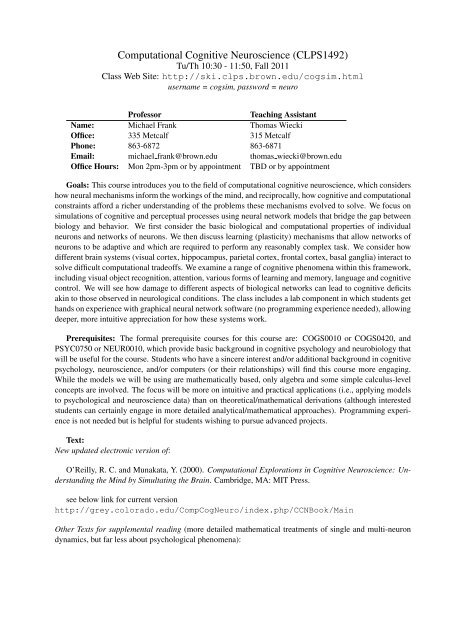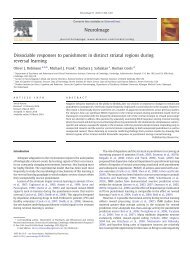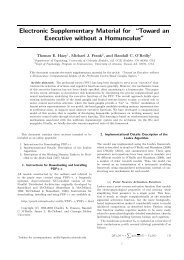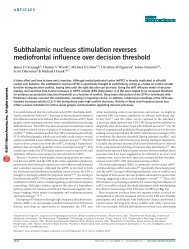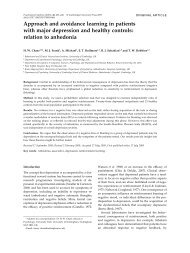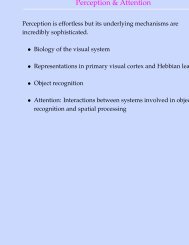Computational Cognitive Neuroscience (CLPS1492) - Michael Frank
Computational Cognitive Neuroscience (CLPS1492) - Michael Frank
Computational Cognitive Neuroscience (CLPS1492) - Michael Frank
You also want an ePaper? Increase the reach of your titles
YUMPU automatically turns print PDFs into web optimized ePapers that Google loves.
<strong>Computational</strong> <strong>Cognitive</strong> <strong>Neuroscience</strong> (<strong>CLPS1492</strong>)<br />
Tu/Th 10:30 - 11:50, Fall 2011<br />
Class Web Site: http://ski.clps.brown.edu/cogsim.html<br />
username = cogsim, password = neuro<br />
Professor<br />
Teaching Assistant<br />
Name: <strong>Michael</strong> <strong>Frank</strong> Thomas Wiecki<br />
Office: 335 Metcalf 315 Metcalf<br />
Phone: 863-6872 863-6871<br />
Email: michael frank@brown.edu thomas wiecki@brown.edu<br />
Office Hours: Mon 2pm-3pm or by appointment TBD or by appointment<br />
Goals: This course introduces you to the field of computational cognitive neuroscience, which considers<br />
how neural mechanisms inform the workings of the mind, and reciprocally, how cognitive and computational<br />
constraints afford a richer understanding of the problems these mechanisms evolved to solve. We focus on<br />
simulations of cognitive and perceptual processes using neural network models that bridge the gap between<br />
biology and behavior. We first consider the basic biological and computational properties of individual<br />
neurons and networks of neurons. We then discuss learning (plasticity) mechanisms that allow networks of<br />
neurons to be adaptive and which are required to perform any reasonably complex task. We consider how<br />
different brain systems (visual cortex, hippocampus, parietal cortex, frontal cortex, basal ganglia) interact to<br />
solve difficult computational tradeoffs. We examine a range of cognitive phenomena within this framework,<br />
including visual object recognition, attention, various forms of learning and memory, language and cognitive<br />
control. We will see how damage to different aspects of biological networks can lead to cognitive deficits<br />
akin to those observed in neurological conditions. The class includes a lab component in which students get<br />
hands on experience with graphical neural network software (no programming experience needed), allowing<br />
deeper, more intuitive appreciation for how these systems work.<br />
Prerequisites: The formal prerequisite courses for this course are: COGS0010 or COGS0420, and<br />
PSYC0750 or NEUR0010, which provide basic background in cognitive psychology and neurobiology that<br />
will be useful for the course. Students who have a sincere interest and/or additional background in cognitive<br />
psychology, neuroscience, and/or computers (or their relationships) will find this course more engaging.<br />
While the models we will be using are mathematically based, only algebra and some simple calculus-level<br />
concepts are involved. The focus will be more on intuitive and practical applications (i.e., applying models<br />
to psychological and neuroscience data) than on theoretical/mathematical derivations (although interested<br />
students can certainly engage in more detailed analytical/mathematical approaches). Programming experience<br />
is not needed but is helpful for students wishing to pursue advanced projects.<br />
Text:<br />
New updated electronic version of:<br />
O’Reilly, R. C. and Munakata, Y. (2000). <strong>Computational</strong> Explorations in <strong>Cognitive</strong> <strong>Neuroscience</strong>: Understanding<br />
the Mind by Simultating the Brain. Cambridge, MA: MIT Press.<br />
see below link for current version<br />
http://grey.colorado.edu/CompCogNeuro/index.php/CCNBook/Main<br />
Other Texts for supplemental reading (more detailed mathematical treatments of single and multi-neuron<br />
dynamics, but far less about psychological phenomena):
<strong>Computational</strong> <strong>Cognitive</strong> <strong>Neuroscience</strong> <strong>CLPS1492</strong> 2<br />
Dayan, P. and Abbott, L.F. (2001) Theoretical <strong>Neuroscience</strong>. MIT Press<br />
Izhikevich, E.M. (2007) Dynamical Systems in <strong>Neuroscience</strong>. MIT Press<br />
Lab: In addition to lecture, there is a weekly 2 hour lab session led by the TA, where students obtain<br />
in-depth hands-on experience with the computer simulation explorations. These explorations are the centerpiece<br />
of the course, and provide a unique exploratory learning opportunity. You will perform many what-if<br />
scenarious to understand what aspects of the brain’s biology are important for producing specific cognitive<br />
phenomena. You will simulate the effects of brain damage in these models, to understand neuropsychology.<br />
The computer models enable complete control and dynamic, colorful visualization of these explorations,<br />
providing a unique ability to understand how cognition emerges from the brain. You will document these<br />
explorations by answering the simulation exercises questions (to be worked on during the lab sessions). You<br />
should be able to do most of the required homework during these lab sessions.<br />
Evaluation: Your grade will be based on three components in the following proportions:<br />
Simulation exercises 35%<br />
Reading reactions 10%<br />
Midterm miniproject 10%<br />
Final project 35%<br />
Class participation 10%<br />
Simulation Exercises: The textbook comes with a large number of “pre-built” neural network models<br />
that illustrate key principles and phenomena. Every week, you will explore these pre-built models, and<br />
you will document these explorations by answering questions from the textbook. For each chapter of the<br />
textbook, I will tell you which simulation exercises to do. If you start doing the exercises before you receive<br />
this assignment, you risk doing some exercises that are not in the assignment (which is not the worst thing,<br />
but you have been warned). You should write up all of the assigned simulation exercises for each chapter and<br />
turn them in in class on the date specified on the syllabus. Although you will be working on these exercises<br />
in the labs, you must write them up individually. We want to see that each person individually understands<br />
the material, so this should be evident in your writeup. It is best to write down results and first drafts of<br />
answers as you work through the exercises; they can sometimes take a while to run and you don’t want to<br />
have to run them repeatedly. Exercises turned in late will be penalized 5% for each day after the due date.<br />
Collaboration: You are allowed to discuss the simulation exercises with other students in the class<br />
(indeed, this will be a regular part of the weekly lab sessions). However, you must write them up individually.<br />
If you discuss one of the exercises at length with another student, it is always a good idea to list that other<br />
student’s name in your response (e.g., “I worked with Tom Petty on this question”). This process of listing<br />
names protects you from ethics problems, in the following sense: If students X and Y state outright that they<br />
worked together on a question, and I think that their answers are too similar, I do not consider this an ethics<br />
violation; rather, I will just tell X and Y that they should try harder to come up with different responses (and<br />
maybe deduct a few points). However, if X and Y hand in identical, idiosyncratic answers, and they do not<br />
list each other as having worked together, this constitutes an ethics violation because they are representing<br />
their work to be entirely their own, when in fact it is not.<br />
Reading reactions: For each chapter, you will be asked to email a few sentences about the topic you<br />
found most interesting in the chapter and why. These reading reactions are designed to ensure that you are<br />
keeping up on the reading and to inform us about your interests. Reading reactions should be emailed to<br />
michael frank@brown.edu and thomas wiecki@brown.edu, prior to the class meeting when they are due.
<strong>Computational</strong> <strong>Cognitive</strong> <strong>Neuroscience</strong> <strong>CLPS1492</strong> 3<br />
Final Project: In the final project, you will conduct your own simulations to examine some phenomenon<br />
of interest to you (as one example, “the role of oscillations in memory consolidation”). This will involve<br />
either adding an extension to an existing model that we covered or building a new one from scratch. Do not<br />
be overly ambitious — relatively clear and simple but thoughtful work is much preferred to a complicated<br />
half-baked mess. Do not be misled by the relative simplicity of running the canned exercises in the book<br />
— simulation projects take a long time to complete! The TA and professor will consult with you to develop<br />
and refine a tractable project. You will also have the opportunity to complete a shorter, directed, midterm<br />
project that will help you develop skills with the software that will be useful for the final project.<br />
Undergraduates can work in groups of 2, but each of you will have to contribute independently and each<br />
of you will have to write up separate components of the final paper. The following timeline is designed to<br />
ensure that you make progress on your project and that you receive feedback on it before turning in the final<br />
version.<br />
Deadline<br />
Oct 21<br />
Nov 3<br />
Nov 8<br />
Nov 8 - 18<br />
Nov 30 - Dec 2<br />
Dec 16<br />
Assignment<br />
Midterm mini-project<br />
Project topic<br />
Project proposal (1 page summary and approach to explore thru simulations or lit review)<br />
Meeting w/ TA and instructor about project<br />
Presentation of project to class<br />
Final paper<br />
A final paper describing your project is due Dec 16. This paper should be 10-15 pages (double spaced,<br />
excluding figures), and should contain a concise introduction to the psychological issue or phenomenon, a<br />
justification of your (or others’) general approach to modeling it, methods, results, and a concluding discussion<br />
(about the significance of your results, what you might do to improve your model, etc.). Network<br />
diagrams and graphs of significant results should be included. However, do not include excessive or redundant<br />
figures; the text should provide a clear interpretation and justification of all figures. NOTE: For each<br />
day that the final paper is late, 5% will be deducted from your final paper grade.<br />
Class Participation: Productive participation in class discussion is encouraged to help you get the most<br />
out of this course. You are expected to read the text chapters the week they are assigned and to come to class<br />
prepared to actively participate in discussion.<br />
Grads & Undergrads: This course is designed for advanced undergraduates and graduate students.<br />
Undergrads need not feel intimidated by the presence of graduate students in the class. More will be expected<br />
of the grads than the undergrads, especially when it comes to the final projects.<br />
Grading Policy: Grades are not curved; they are based on percentages:<br />
85-100 A 75-85 B 65-75 C
<strong>Computational</strong> <strong>Cognitive</strong> <strong>Neuroscience</strong> <strong>CLPS1492</strong> 4<br />
I reserve the right to change the schedule as the semester progresses. The most up-to-date<br />
version will always be posted on the class web-site.<br />
Schedule<br />
Ch = Chapter in text to read, Due = Materials due in class (HW = homework, RR = reading reaction), MidProj<br />
= Mid-term mini project, Top = Paper topic, Prop = Final project proposal, Meet = Meet with instructor this week to<br />
discuss proposals. Paper = Final papers due by 5:00pm via email.


